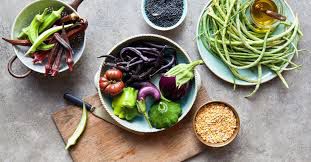ARTICLES
Low-Potassium Meals for Kidney Patients
Low-Potassium Meals for Kidney Patients

For people with kidney problems, managing potassium levels isn’t just about avoiding bananas and potatoes. It’s about protecting your heart and preventing dangerous complications. When your kidneys can’t filter excess potassium from your blood effectively, it builds up—leading to muscle weakness, irregular heartbeat, or even sudden cardiac arrest. That’s why creating low-potassium meals is one of the smartest dietary changes you can make if your kidney function is compromised.
1. Understand Why Potassium Matters
Potassium plays a role in nerve signals, muscle movement, and fluid balance. Normally, your kidneys remove any excess through urine. But if your kidneys are damaged or failing, potassium stays in your bloodstream. This can lead to a condition called hyperkalemia, which puts your heart at serious risk. That’s why a low-potassium diet becomes a lifesaving choice, not just a preference.
2. Choose the Right Cooking Methods
How you prepare food makes a big difference. Boiling vegetables in plenty of water can pull potassium out and lower their content. This works especially well for high-potassium foods like potatoes, carrots, and spinach. Always discard the cooking water. Avoid frying or baking high-potassium vegetables unless they’ve been pre-boiled and drained.
3. Stick With Low-Potassium Vegetables
Not all vegetables are off-limits. Cabbage, cauliflower, cucumber, lettuce, and bell peppers are lower in potassium and kidney-friendly. These can be eaten raw, steamed, or boiled without major concern. They add color, crunch, and nutrients without overwhelming your potassium levels.
4. Watch Your Portion Sizes
Even low-potassium foods can add up if you eat large quantities. It’s not just about what you eat, but how much. Stick to recommended serving sizes and spread your intake throughout the day instead of loading up on a single large meal. Portion control is critical when you’re managing potassium.
ALSO READ: Signs of Kidney Damage You Shouldn’t Ignore
5. Avoid Salt Substitutes
Many salt substitutes contain potassium chloride instead of sodium chloride. While they seem like a healthy swap, they’re dangerous for people with kidney disease. Always check labels and avoid anything labeled “low-sodium” or “salt substitute” unless it’s been cleared by your doctor or dietitian.
6. Swap High-Potassium Fruits for Safer Options
Fruits like bananas, oranges, avocados, and mangoes are high in potassium. Instead, reach for apples, grapes, berries, pineapples, and watermelon. These options are naturally lower in potassium and can still satisfy your sweet cravings without putting stress on your kidneys.
ALSO READ: How High Blood Pressure Affects Kidney Function
7. Read Food Labels Closely
Processed and packaged foods may not taste salty or sweet, but they often contain hidden potassium additives. Watch out for ingredients like potassium lactate, potassium phosphate, or potassium citrate. These are commonly used in meats, snacks, and even dairy products. Choosing fresh, whole foods gives you more control.
8. Replace Beans and Lentils Wisely
Legumes are healthy for most people, but kidney patients need to limit them due to high potassium. Instead of using regular beans, try small amounts of canned, low-sodium white beans that have been rinsed and soaked. You can also get protein from egg whites, lean chicken, or fish—all of which are safer options.
9. Make Simple Low-Potassium Meal Ideas
Start your day with scrambled egg whites, toast with unsalted butter, and a side of apples. For lunch, go for a cabbage and cucumber salad with grilled chicken and rice. Dinner could include white pasta with garlic sauce and steamed cauliflower. These meals stay within potassium limits while offering variety.
ALSO READ: How to Protect Your Kidneys from Diabetes
10. Skip High-Potassium Condiments
Tomato sauces, soy sauce, and barbecue sauces are often loaded with potassium and sodium. Try garlic, lemon juice, herbs, or homemade sauces instead. These bring flavor to your food without the hidden risks.
ALSO READ: Best Foods to Lower Blood Pressure Naturally
11. Watch Out for Dairy Products
Milk and yogurt are rich in potassium. If you’re craving dairy, opt for smaller portions or consider rice milk (without added potassium) or non-dairy creamers. Check labels, since many plant-based products add potassium for texture or flavor.
12. Stay Consistent With Your Choices
Randomly mixing high- and low-potassium meals throughout the week can throw off your balance. Consistency matters. Stick to low-potassium ingredients regularly and keep track of how your body responds. This helps avoid spikes in potassium that could lead to dangerous symptoms.
13. Talk With a Renal Dietitian
Creating a diet plan with a professional who understands kidney health can be incredibly helpful. A renal dietitian can help you find the right combinations of foods that match your taste preferences while keeping your potassium levels safe.
14. Don’t Forget to Stay Hydrated
Proper hydration supports kidney function and helps flush out excess potassium—if your kidneys are still able to manage some filtration. But don’t drink excessively unless advised by a doctor. Balance is key.
ALSO READ: Foods to Avoid If You Have Kidney Problems
Discover more from 9jaPolyTv
Subscribe to get the latest posts sent to your email.

 EDUCATION3 hours ago
EDUCATION3 hours agoCall for Applications: GET Compass Grant Program for MSMEs (Up to ₦2 Million in Funding)

 EDUCATION3 hours ago
EDUCATION3 hours agoNELFUND loans’ll pay fees students are charged — Alausa

 EDUCATION3 hours ago
EDUCATION3 hours agoJAMB gives tertiary institutions end-of-year deadline for 2025 admissions

 UNIVERSITY NEWS2 hours ago
UNIVERSITY NEWS2 hours agoNew Ekiti varsity to begin admission, staff recruitment September – VC

 EDUCATION2 hours ago
EDUCATION2 hours agoCall for Applications: Female Scholars Foundation Scholarship 2025 for Nigerian Undergraduates

 ARTICLES2 hours ago
ARTICLES2 hours agoAre Plantains Healthy? Nutrition Facts, Benefits, and the Best Ways to Enjoy Them






























